Algae are part of complex biological interactions.
- They are fed on (grazed), and grazing can control their abundance; zooplankton grazing can account for 80-100% of daily algal growth and production
- They have mechanisms to defeat grazing
- They provide habitat for numerous protists and animals
- They can be infected by parasites or phathogenes
- They can be parasites or grazers on other algae and bacteria themselves
- They can live in symbiosis with other plants and animals
- They can „culture“ beneficial bacteria on their surface
- They can chemically alter the water quality (toxins)
- They are in constant competition with other algae for essential resources (nutrients, light, habitat space)
- The grazing on algae is called herbivory, those grazing on algae are herbivores
- Algae can be grazed by filter feeding or raptional feeding
- Filter feeders are typically much larger than their food; the size range of their food is dictated by the „mesh size“ of their filters
- Raptoral feeders can be closer in size to their prey; ciliates and heterotrophic dinoflagellates can ingest food of their own size
- Raptoral feeders can taste their food and reject harmful food or food of lesser quality

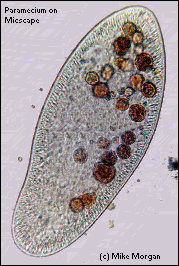
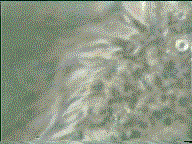
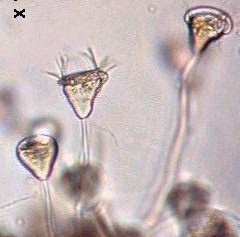
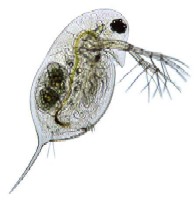
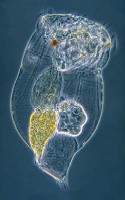
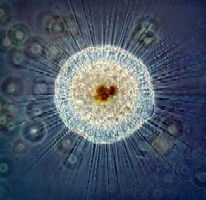

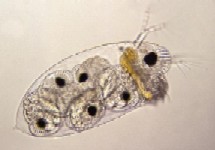
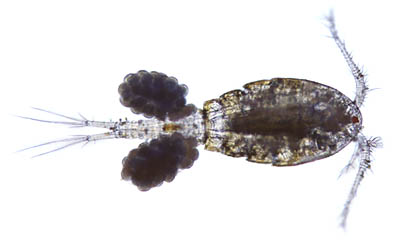
- Colony formation produces larger particles for grazers to cope with
- Cellular envelopes or mucilage sheaths
- Spines and bristles on cell surface
- Spiny or bulky cell shape
- Rigid cell walls to pass through zooplankton gut without digestion
- Bioluminescence
- Cellular toxins
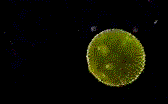
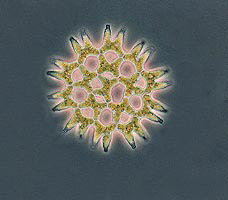

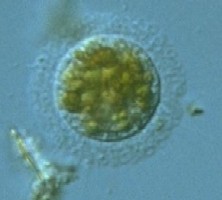
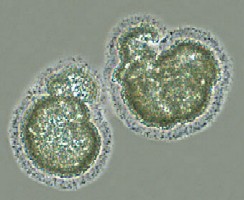
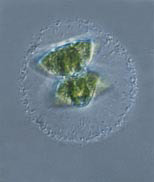

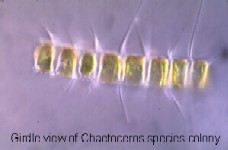
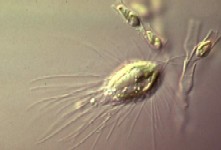

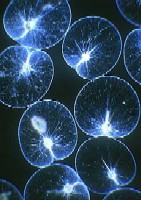
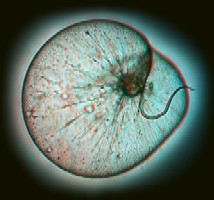
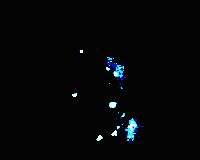
Lower panel: bioluminescence by the dinoflagellate Noctiluca miliaris
- 30% of phytoplankton in oligotrophic lakes and oceans are found to be mixotrophic.
- Most phagotrophic algae are flagellates, predominantly of the groups Euglenophytes, Dinophytes, and Chrysophytes
- Many of those species carry chlorophyll and perform photosynthesis
- Dinoflagellates can produce a pallium (extension of their cell membrane) to „fish“ for prey
- Dinoflagellates are known parasites of other phytoplankton
- The dinoflagellate Pfisteria piscida exhibits at least 24 life cycle stages, phototrophic and heterotrophic flagellates as well as amoeboid stages; it preys on fish tissue and causes massive fish kills and human desease in Carolina estuaries; occurrence is spreading from Chesapeake Bay to Florida

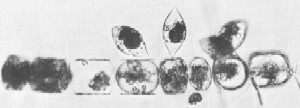


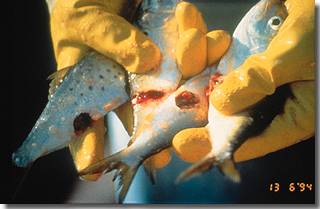

- Mass development of dinoflagellates (>108 cells l-1) discolor water; mostly related to nutrient input by rain or drainage from fields and pig/chicken farms or sewage input
- Paralytic Shellfish Poisoning (PSP): Algal cells contain highly lethal saxitoxin; accumulation of toxin in clams, mussel, scallops, fish lead to poisoning of humans; symptoms neurological, heart arrest in most severe cases after 24 hrs; closure of mussel beds
- Neurotoxic Shellfish Poisoning (NSP): algal toxin is brevetoxin (Gymnodinium breve); neurological & gastrointestinal symptoms; aerosols can produce asthma; no deaths reported
- Diarrhetic Shellfish Poisoning (DSP): Okadaic acid, Dinophysis sp.; gastrointestinal symptoms (diarrhea, cramps) 30 min after consumption of toxic shellfish, not lethal, recovery ca. 3 days
- Ciguatera Fish Poisoning (CFP): Ciguatoxin, gastrointestinal, neurological, and cardiovascular symptoms; paralysis and death documented, but usually less severe; mostly tropical waters
- Amnesic shellfish poisioning (ASP), Domoic Acid (DA): A neurotoxin produced by the diatom Pseudo-Nitzschia multiseries; causes or toxic encephalopathy in humans; deplorization of neurons, neuron degeneration,memory loss and death; toxin triggered by P-limitation
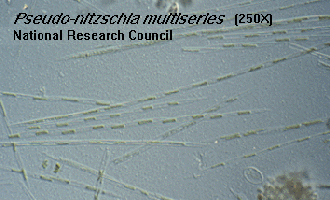
- Ca. 50-75% of cyanobacteria blooms generate toxins
- Lipopolysaccharides (LPS): endotoxins of cell envelopes of Anabaena, Synechococcus, Microcystis; fever and inflammation in humans
- Hepatotoxins: cyclic peptides, most frequent cause for animal illness and deaths upon drinking of infested water; Microcystis, Anabaena, Nostoc, Oscillatoria; weakness, heavy breathing, diarrhea, liver bleeding causing death within 2-24 hrs, tumor-promoting; some cases of human illness and deaths confirmed
- Neurotoxins: Anatoxin by Anabaena flos-aquae and others
- Saxotoxins occur in some cyanobacteria but more in eukaryotes
- Fungal parasites: mostly specific to few hosts; Chytrids, simple, non-mycelian fungi, reproduction by zoospores that find host by chemical cues; Phycomycetes, mycelian fungi in large diatoms
- Protozoan parasites: a number of heterotrophic flagellates and dinoflagellates „pierce“ algal cells and empty them; amoeba can live within algal cells
- Bacterial pathogens: often observed associations of bacteria on micro- and macroalgal surfaces seem to be mutualistic; pathogenic and saprophytic bacteria occur as endoparasites; myxobacteria and Bdellovibrio bacteria attack and lyse cyanobacteria; several coral deseases (coral bleaching) were related to bacteria pathogenic to the algal symbionts of corals
- Viral pathogens: numerous viruses infact phytoplankton and macroalgae; pelagic virus abundance is 104-108 ml-1; estimated 3% of primary production is lost to viral lysis of phytoplankton cells, and viruses are discussed as causes for abruptly decaying phytoplankton blooms; research active only for a few years
- Algal defense against pathogens: very poorly understood
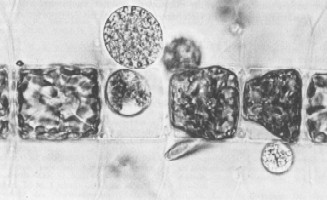
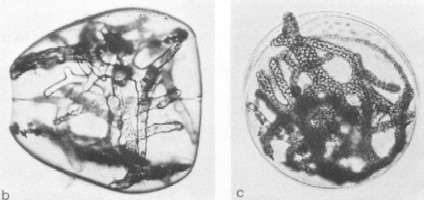
Left: chytrids on diatom chain; right: phycomycetes inside diatom frustles
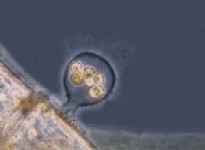

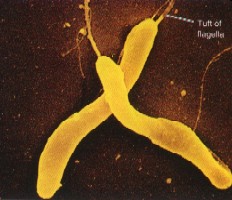
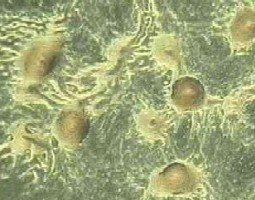
Left: Bdellovibrio-like bacterium; right: mycobacteria colonies
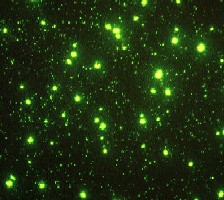

Left: Epifluorescence microscopy slide of DNA-stained bacteria (larger green spheres) and viruses (small green spheres); right: TEM phycovirus
- Epibionts and epiphytes: algae that live on the surface of other algae (epiphytes) or animals (epibionts)
- Algae as pathogenes: cyanobacteria cause death of coral symbionts and coral bleaching (black band desease); pathogenes for malaria are related to dinoflagellates and contain degenerated plastids; 15% of all red algae are parasites on other, mostly related red algae; parasitic green algae infest plant leaves as endophytes; Prototheca spp., colorless gree algae, can cause skin infections in humans
- Algal-bacterial associations:
- 1) bacteria on planktonic algae;
- 2) bacteria on macroalgal surfaces;
- 3) algae and bacteria in structured benthic mats.
- Algae provide organic compounds, bacteria provide growth factors, vitamins, nutrients
- Lichens: stable, self-supporting unit of fungi and green algae (85%) or cyanobacteria (10%) or both
- Cyanobacterial-plant associations: a number of mosses, ferns and higher plants (angiosperms) are associated with nitrogen-fixing cyanobacteria; the plants profit from the additional N source
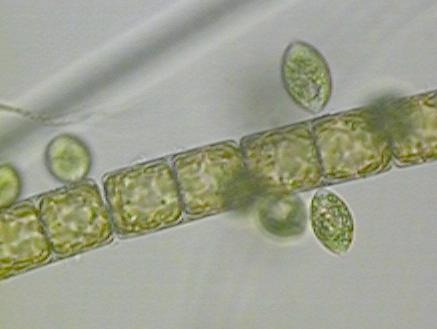
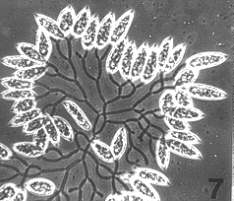
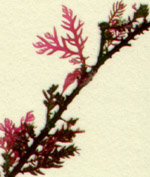
Left: Colacium (Eugleonid) on green agla and agar; right: red alga growing on related red alga
Left: parasitic green alga Cephaleuros on Magnolia leave (copyright 1986 The American Phytopathological Society); right: parasitic green alga Trentepholia on tree (Russel Chapman, LSU).
Algal Symbioses
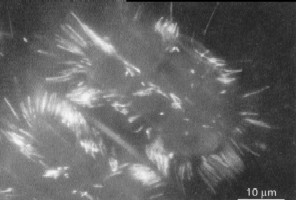
Bacteria (bright) on the green alga Scenedesmus; fluorescence microscopy

Cross-section through a lichen, symbiontic algae stained red
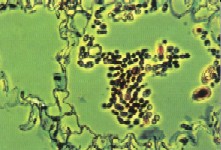
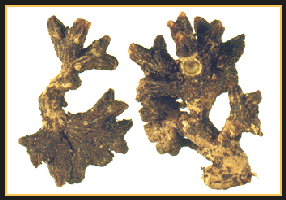
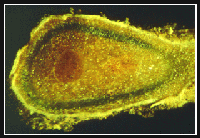
Left: Cross-section through the aquatic fern Azolla, showing filaments of the nitrogen fixing cyanobacterium Anabaena in large cavities; mid: coralloid root of a cycad; right: cross-section through coralloid root, layer of N fixing Nostoc visible as dark green ring